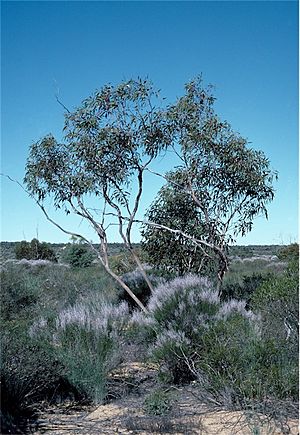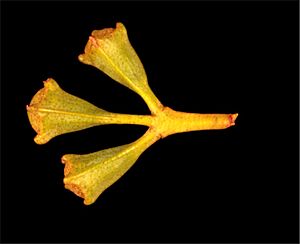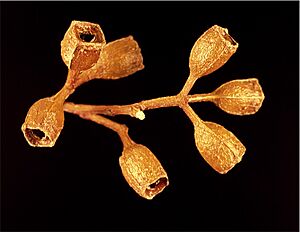Northern sandplain mallee facts for kids
Quick facts for kids Northern sandplain mallee |
|
|---|---|
 |
|
| Eucalyptus gittinsii near the Murchison River | |
| Scientific classification | |
| Genus: |
Eucalyptus
|
| Species: |
gittinsii
|
The Eucalyptus gittinsii, also known as the northern sandplain mallee, is a special type of tree found only in Western Australia. It's called a mallee because it usually grows as a shrub with many stems from the ground. This plant has smooth greyish bark, but sometimes it has rough, flaky bark near its base. Its leaves are shaped like a spear or are slightly curved. It produces whitish flowers and its fruit looks like a cylinder or a barrel.
Contents
What it Looks Like
Eucalyptus gittinsii is a mallee that typically grows to be about 2 to 5 meters (6.5 to 16 feet) tall. It has a special woody swelling at its base called a lignotuber. This helps the plant regrow after a fire.
Its bark is usually smooth and can be brownish to white. Sometimes, you might see rough, flaky bark peeling off near the bottom of the trunk.
Young plants and new shoots (called coppice regrowth) have leaves that grow in opposite pairs. These leaves are broadly spear-shaped, about 55 to 110 millimeters (2.2 to 4.3 inches) long and 30 to 50 millimeters (1.2 to 2 inches) wide.
As the plant gets older, its leaves change. Adult leaves grow one after another, not in pairs. They are spear-shaped or slightly curved, about 75 to 130 millimeters (3 to 5 inches) long and 12 to 30 millimeters (0.5 to 1.2 inches) wide. These leaves are attached to a stalk called a petiole, which is about 10 to 30 millimeters (0.4 to 1.2 inches) long.
Flowers and Fruit
The flower buds grow in groups of three where the leaves meet the stem (called leaf axils). They are on a stalk called a peduncle, which is about 5 to 18 millimeters (0.2 to 0.7 inches) long. Each individual bud has its own small stalk, called a pedicel, about 2 to 8 millimeters (0.08 to 0.3 inches) long.
When the buds are ready, they are club-shaped, about 6 to 8 millimeters (0.2 to 0.3 inches) long and 4 to 5 millimeters (0.16 to 0.2 inches) wide. They have a rounded or flattened cap on top, called an operculum.
This plant usually flowers between December and February. Its flowers are white or off-white. After flowering, the plant produces a woody fruit. This fruit is a capsule that looks like a cylinder or a barrel. It's usually somewhat square when you look at it from the end, about 10 to 17 millimeters (0.4 to 0.7 inches) long and 7 to 12 millimeters (0.3 to 0.5 inches) wide.
Naming the Plant
Eucalyptus gittinsii was first officially described in 1978. Two scientists, Ian Brooker and Donald Blaxell, wrote about it in a science journal called Nuytsia. They studied a sample that Blaxell collected in 1975.
The second part of the plant's name, gittinsii, was chosen to honor Clifford Halliday Gittins (1904 - 1995). He helped the National Herbarium of New South Wales a lot with their plant studies.
Different Types
In 2000, another scientist named Dean Nicolle found that there are two slightly different types, or subspecies, of Eucalyptus gittinsii. These names are now accepted by the Australian Plant Census:
- Eucalyptus gittinsii Brooker & Blaxell gittinsii: This type has shiny green adult leaves.
- Eucalyptus gittinsii subsp. illucida D.Nicolle: This type has dull, light green or bluish-green adult leaves.
Where it Grows
The northern sandplain mallee is found along the west coast of Western Australia. It likes to grow in sandy areas, including sand dunes and ridges. You can find it in the Mid West and Wheatbelt regions of Western Australia. It prefers sandy soils, often with a type of gravel called lateritic gravel.
The subspecies gittinsii grows in and near the Kalbarri National Park. The subspecies illucida is found between Three Springs and the Moore River.
Conservation Status
Both subspecies of E. gittinsii are considered "not threatened" by the Western Australian Government's Department of Parks and Wildlife. This means they are not currently at risk of disappearing.



